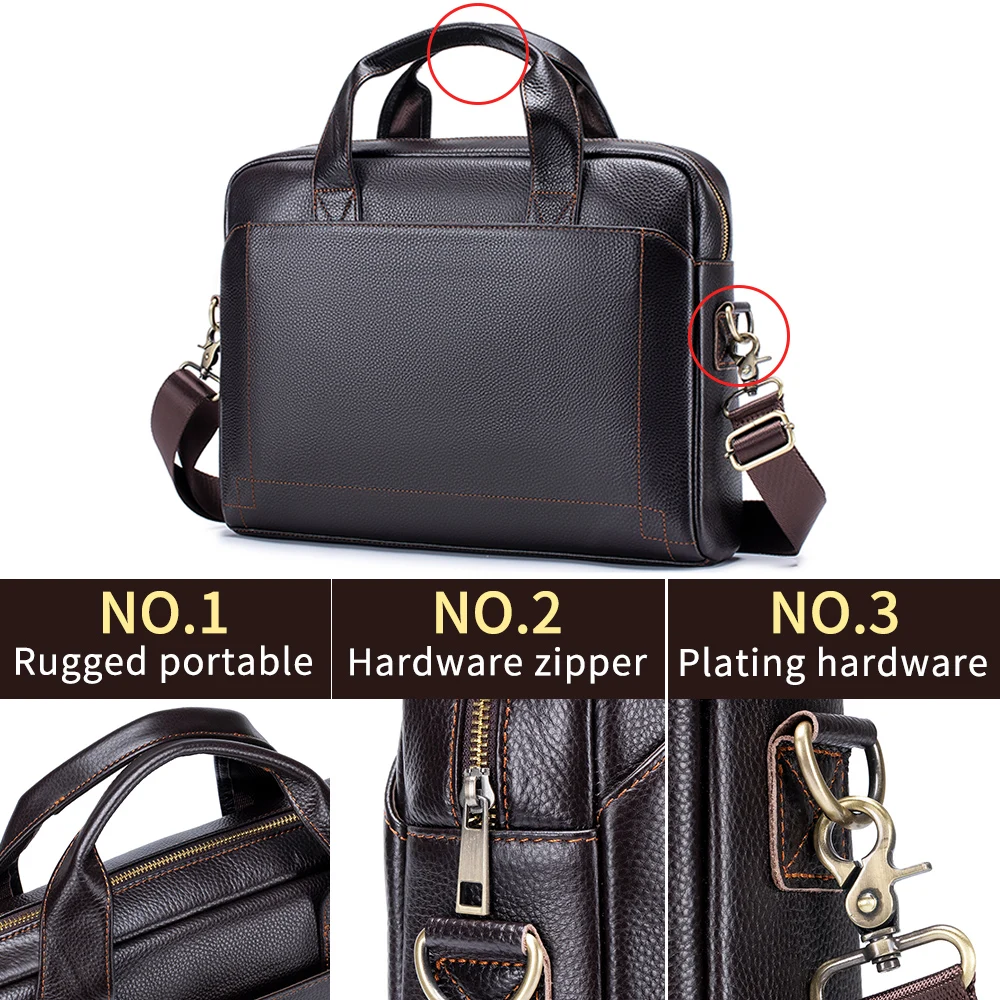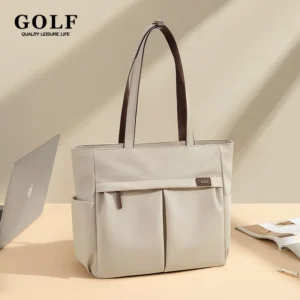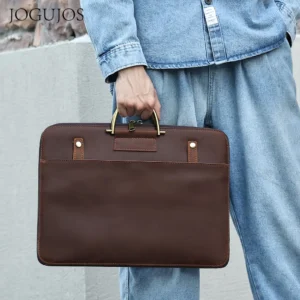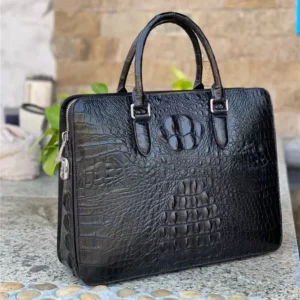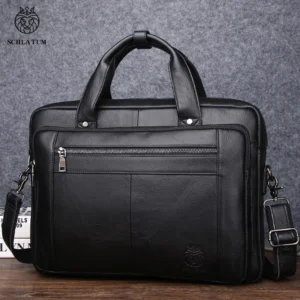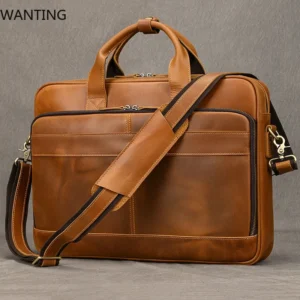Understanding Why Briefcase Size Matters
Selecting the right briefcase size is more than a matter of preference—it’s about functionality, comfort, and professional image. When your briefcase is too large, it can appear unwieldy and cumbersome, potentially making you look disorganized. Conversely, a briefcase that’s too small might suggest you’re unprepared for the demands of your workday.
The size of your work bag directly impacts your physical comfort throughout the day. Many professionals experience shoulder and back strain from carrying improperly sized briefcases during their daily commutes. According to ergonomic experts, an overloaded or poorly balanced briefcase can contribute to chronic pain and posture problems over time.
Beyond comfort, the right size ensures better protection for your valuable devices and important documents. A properly sized briefcase provides adequate padding and prevents items from shifting excessively during transport. This protection factor alone can save you from costly repairs or document replacements.
Consider James, a financial analyst who struggled with an oversized briefcase on his subway commute. The bulky bag constantly bumped other passengers, got caught in closing doors, and made finding his items frustratingly difficult. After switching to a properly sized option, his commute became noticeably less stressful.
The perfect size also enhances organization and functionality, with appropriate compartments for your specific needs. Understanding timeless classic leather briefcase characteristics helps establish what factors matter most when selecting the right size for your professional requirements.
Assessing Your Briefcase Needs: What Will You Carry?
Before considering specific dimensions, take inventory of what you’ll carry daily. This honest assessment forms the foundation for making the right size choice.
Start by gathering everything you typically take to work and categorizing these items:
- Technology devices: Laptop, tablet, smartphone (measure dimensions precisely)
- Documents and paperwork: Files, folders, notebooks, planners, legal pads
- Tech accessories: Chargers, cables, power banks, adapters, headphones
- Office supplies: Pens, business cards, stapler, sticky notes, calculator
- Personal items: Wallet, keys, sunglasses, medication, water bottle
- Occasional items: Umbrella, light sweater, lunch container
Different professionals have varying needs. An executive might prioritize space for a tablet and minimal paperwork, while a lawyer might need room for numerous legal documents. A creative professional might carry a sketchbook and specialized tools, while consultants often need space for client presentations and reports.
Think about future-proofing your purchase as well. If you’re likely to upgrade to a larger laptop soon or anticipate changing roles that require additional materials, factor this into your decision.
Measuring your laptop correctly is crucial—include the width (side to side), depth (front to back), and height (thickness). Don’t forget to account for any protective case your laptop might have, as this adds to the overall dimensions.
Our classic laptop briefcase collection offers options designed specifically with proper technology accommodation in mind, ensuring both protection and professional appearance.
Critical Measurements: Getting Laptop Fit Right
The most important technical measurement for your briefcase is ensuring it properly accommodates your laptop. An ill-fitting laptop compartment can lead to damage or unnecessary wear on your device.
Follow these steps for precise measurement:
- Measure your laptop’s width (left to right when screen is open)
- Measure your laptop’s depth (front to back when closed)
- Measure your laptop’s height (thickness when closed)
- Add 0.5-1 inch (1.3-2.5 cm) to each dimension for proper fit
Remember that briefcase dimensions can be misleading. Manufacturers often list external measurements, but what matters most is the size of the internal padded compartment. When reviewing product specifications, look specifically for internal laptop compartment dimensions.
The ideal laptop fit should be snug but not tight. Your device should sit securely without excessive movement, yet you should be able to remove it easily. A good rule of thumb is to have about half an inch of cushioning space on each side.
If you use a protective sleeve or case for your laptop, factor this into your measurements. The combined dimensions of your laptop plus its sleeve must fit comfortably in the briefcase’s laptop compartment.
Common laptop sizes and their dimensions include:
– 13-inch: approximately 12.8” × 8.9” × 0.7” (32.5 × 22.6 × 1.8 cm)
– 15-inch: approximately 14.1” × 9.7” × 0.7” (35.8 × 24.6 × 1.8 cm)
– 17-inch: approximately 16.3” × 10.8” × 0.8” (41.4 × 27.4 × 2.0 cm)
For detailed specifications regarding proper fit, our definitive guide on leather laptop bag dimensions provides comprehensive information about matching your specific device to the right bag size.
Matching Your Briefcase to Your Professional Environment
The appropriate briefcase size varies significantly based on your workplace culture and industry standards. In highly formal corporate environments, a streamlined, moderate-sized briefcase often conveys polish and efficiency. In contrast, creative fields might allow for larger, more distinctive options that showcase personality.
Industry-specific considerations include:
Legal Professionals: Often need larger briefcases to accommodate legal-sized documents, multiple client files, and reference materials. A wide briefcase with a depth of at least 5 inches is typically necessary.
Corporate Executives: Generally benefit from medium-sized briefcases that project efficiency and organization while accommodating essentials for meetings throughout the day.
Creative Professionals: May require space for portfolios, tablets with styluses, or specialized equipment, often favoring briefcases with flexible compartments.
Medical Professionals: Typically need room for reference materials, possibly a tablet for patient information, and sometimes personal protective equipment.
Your commute significantly impacts the ideal briefcase size. Walking long distances calls for something lighter and more compact, while driving allows for a larger option. Public transit users should consider a size that fits comfortably on their lap or under a seat without inconveniencing others.
Travel requirements also matter—frequent flyers should ensure their briefcase qualifies as a personal item (typically under 18” × 14” × 8”) and has enough organization to access essentials quickly during security checks.
Finding the balance between professional image and practical needs is essential. The process of choosing the perfect leather briefcase involves considering both your professional environment and practical daily requirements.
Ensuring Comfort and Portability
Even the most attractive briefcase will become a burden if it’s uncomfortable to carry. When fully loaded, your briefcase shouldn’t exceed 10-15% of your body weight for regular daily use. For most adults, this means keeping the total weight under 10-12 pounds (4.5-5.5 kg).
The way you carry your briefcase impacts comfortable sizing:
- Handle-carried briefcases should be proportionate to your arm length and not too heavy, as the weight is concentrated in one hand
- Shoulder strap options distribute weight better but should not be so large that they bump against your body while walking
- Convertible briefcases with backpack functionality offer the best weight distribution for larger sizes
Test comfort by carrying a fully loaded briefcase for at least 5-10 minutes before purchasing. Pay attention to pressure points, strap comfort, and how the weight feels distributed across your body.
Consider your body frame when selecting size. A petite person with a 5‘2” frame might find a 16-inch briefcase overwhelming, while someone with a 6‘3” frame might find the same briefcase perfectly proportioned. The bag should look balanced against your body.
Features that enhance comfort include padded shoulder straps that widen at the shoulder, reinforced handles with proper padding, and balanced weight distribution. Many professionals find that comparing large versus slim briefcase options helps determine which style offers better comfort for their specific needs.
Finding the Right Size for Your Style and Proportions
Briefcase size contributes significantly to your overall professional appearance. The bag should complement your body proportions rather than overwhelm or appear insignificant compared to your frame.
As a general guideline:
* Taller individuals (over 6 feet) can comfortably carry briefcases 16-18 inches wide
* Average-height individuals (5‘6” to 6’) typically look balanced with 15-16 inch briefcases
* Shorter individuals (under 5‘6”) often find 14-15 inch briefcases most proportionate
Beyond height, consider your build. A broader frame can balance a wider briefcase, while a slimmer build might be better complemented by a more compact option.
The material of your briefcase affects its perceived bulk. Structured leather appears more substantial than soft materials like nylon. A 16-inch rigid leather briefcase will look significantly larger than a 16-inch flexible canvas bag. This visual impact should factor into your decision, especially if maintaining a sleek silhouette matters in your profession.
Consider how the briefcase looks when you’re dressed in typical work attire. Bring your regular work jacket or coat when shopping to ensure proportional harmony between your clothing and bag.
The visual weight of your briefcase should align with your professional image. Senior executives often benefit from substantial, well-crafted pieces that convey authority, while those in more active roles might prefer something less imposing.
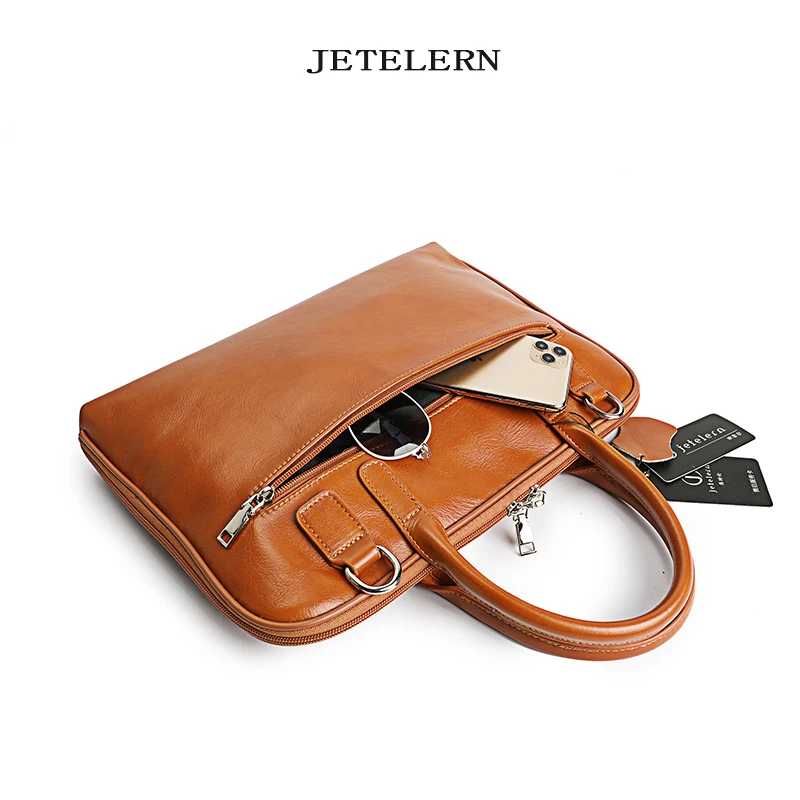
Small Briefcases: Features, Benefits and Limitations
Small briefcases typically measure around 14” W × 11” H × 3” D and offer a sleek, minimalist approach to carrying work essentials. They’re ideal for professionals who’ve embraced digital workflows and carry minimal physical documents.
What typically fits:
* Laptops up to 13-14 inches
* Tablet with slim case
* Small notebook or planner
* Essential chargers and cables
* Basic personal items (wallet, keys, phone)
* A few documents or a slim folder
Advantages:
* Lightweight and easy to carry (typically 2-3 pounds when empty)
* Projects a streamlined, modern professional image
* Easier to manage in crowded spaces like public transit
* Forces discipline in what you carry daily
* Often fits under airline seats with room to spare
Limitations:
* Restricted capacity for documents and accessories
* Limited organizational options and compartments
* May not accommodate larger laptops or tablets
* Not suitable for those who carry multiple devices
* Insufficient for days requiring additional materials or overnight items
Small briefcases excel in scenarios like client meetings, conferences, or workplaces where most materials are digital. They’re perfect for the minimalist professional or as a secondary briefcase for special occasions when you don’t need to bring everything.
For professionals seeking compact options that maintain a polished appearance, our slim leather briefcases collection provides excellent choices that balance size constraints with professional functionality.
Medium Briefcases: The Versatile Choice
Medium briefcases, typically measuring around 16” W × 12.5” H × 4-5” D, represent the most versatile and widely-used option for professionals. They strike an optimal balance between capacity and portability.
What typically fits:
* Laptops ranging from 14-16 inches
* Tablet or e-reader
* Multiple folders or a small binder
* Notebook, planner, and document portfolios
* Full set of charging accessories
* Personal items (wallet, keys, phone, sunglasses)
* Small water bottle or coffee tumbler
* Light snacks or small lunch container
Advantages:
* Versatile enough for most professional scenarios
* Appropriate capacity without excessive bulk
* Sufficient organization features and compartments
* Professional appearance suitable for most industries
* Manageable weight when fully loaded
* Proportionate to most body types
Potential drawbacks:
* Can become heavy if overpacked
* May be slightly large for very petite individuals
* Sometimes too small for overnight business trips
Medium briefcases suit daily commuters, middle managers, and most office professionals who need to balance document carrying with technology needs. They work well across various industries and accommodate changing daily requirements.
These bags typically include better organizational features than smaller options, with dedicated compartments for technology, documents, and accessories. Many medium briefcases feature expandability options for occasional larger loads.
Our collection of classic leather briefcases for men showcases the versatility and professional appeal of this practical size category.
Men's Classic Leather Briefcase, Slim Leather Laptop Briefcase, Slim Leather Portfolio Briefcase
$93.67 Select options This product has multiple variants. The options may be chosen on the product pageLeather Laptop Work Tote, Tan Leather Work Tote, Women's Leather Work Tote, Zippered Leather Work Tote
Price range: $223.62 through $237.97 Select options This product has multiple variants. The options may be chosen on the product pageClassic Laptop Briefcase, Men's Classic Leather Briefcase, Slim Leather Attache Case
Price range: $353.50 through $360.81 Select options This product has multiple variants. The options may be chosen on the product pageBlack Leather Briefcase, Leather Document Bag, Men's Classic Leather Briefcase
Genuine Crocodile Leather Executive Briefcase with Password Lock – Premium Business Document Carrier$1,201.87 Select options This product has multiple variants. The options may be chosen on the product pageBlack Leather Briefcase, Classic Laptop Briefcase, Men's Classic Leather Briefcase, Slim Leather Laptop Briefcase
$228.72 Select options This product has multiple variants. The options may be chosen on the product pageBrown Leather Briefcase, Classic Laptop Briefcase, Crazy Horse Leather Satchel, Men's Classic Leather Briefcase
Price range: $172.15 through $200.02 Select options This product has multiple variants. The options may be chosen on the product page
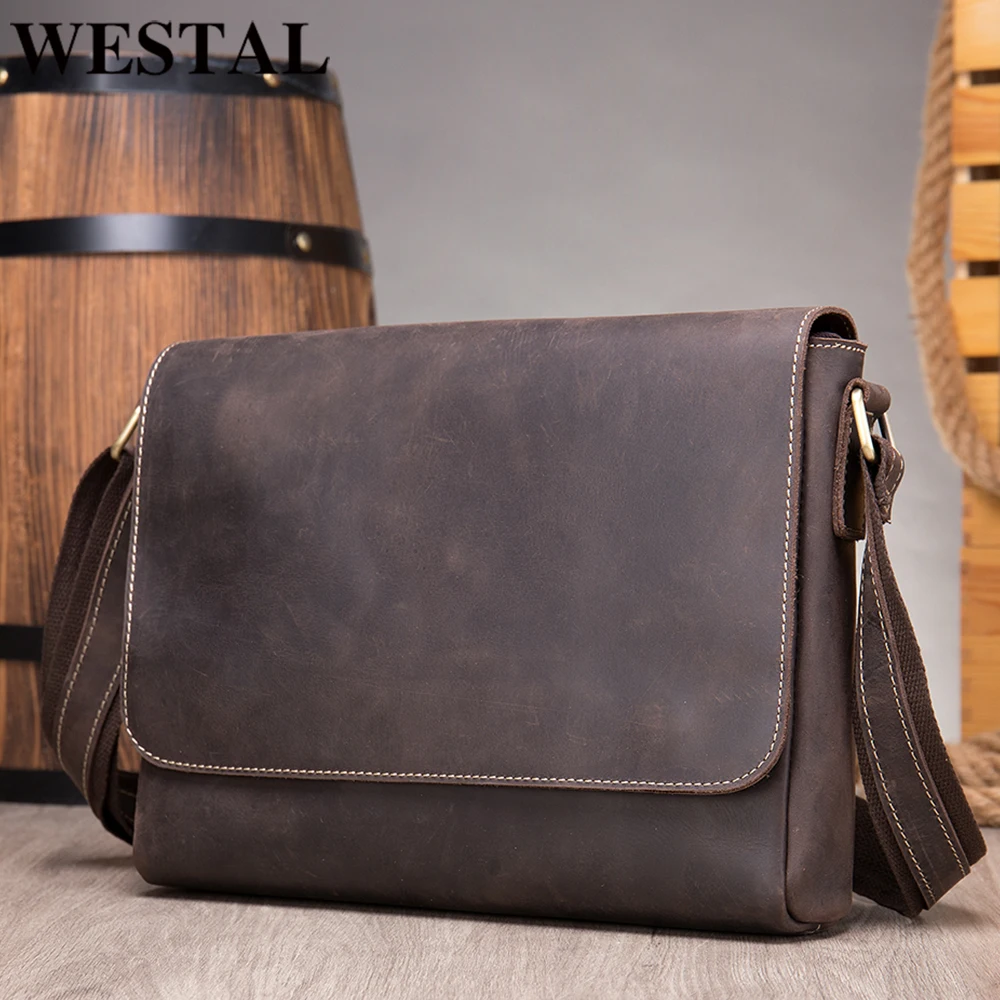
Large Briefcases: Maximum Capacity Options
Large briefcases, with dimensions approximately 18” W × 14” H × 6” D, provide maximum carrying capacity for professionals with substantial daily requirements. These substantial cases blur the line between briefcase and small overnight bag.
What typically fits:
* Larger laptops (17 inches and above)
* Multiple devices (laptop plus tablet)
* Extensive document collections or multiple binders
* Complete set of tech accessories with backup options
* Full-sized notebooks and planners
* Change of clothes or gym attire
* Meal containers and water bottles
* Full complement of personal items
Advantages:
* Maximum storage capacity eliminates need for multiple bags
* Extensive organization options with numerous compartments
* Ability to handle unexpected additions to your carry load
* Often include expandable features for variable capacity
* Ideal for overnight business trips or extensive presentations
Limitations:
* Significant weight even when empty (often 4+ pounds)
* Can look bulky and cumbersome in formal settings
* Challenging to maneuver in tight spaces
* May exceed personal item limits on some airlines
* Can strain shoulders and back when fully loaded
Large briefcases serve professionals who regularly carry extensive materials, need to consolidate multiple bags, or frequently take short business trips. They’re particularly valuable for sales professionals with product samples, educators with grading materials, or executives who travel between offices.
For those whose professional responsibilities demand substantial carrying capacity, our comprehensive professional leather briefcases guide offers insights into selecting larger options that maintain professional appearance without sacrificing functionality.
Quick Reference Size Guide
This comprehensive guide helps you quickly determine which briefcase size category best matches your specific needs:
| Size Category | Typical Dimensions (W × H × D) | Laptop Fit | Recommended Use Cases | Key Advantages |
|---|---|---|---|---|
| Small | 14” × 11” × 3” (35.6 × 27.9 × 7.6 cm) | Up to 14” | Minimalist professionals, short meetings, tablet users | Lightweight, sleek appearance, easiest to carry |
| Medium | 16” × 12.5” × 4-5” (40.6 × 31.8 × 10.2-12.7 cm) | 14-16” | Daily commuters, office professionals, most industries | Versatile capacity, professional appearance, good organization |
| Large | 18” × 14” × 6” (45.7 × 35.6 × 15.2 cm) | 17”+ | Heavy carriers, frequent travelers, educators, sales professionals | Maximum storage, trip-worthy, consolidates multiple bags |
When assessing your needs, remember that weight increases significantly with size. A fully packed large briefcase can easily weigh 15+ pounds (6.8+ kg), while a small briefcase typically stays under 8 pounds (3.6 kg) when loaded.
For those seeking alternatives to traditional briefcases while maintaining professional appearance, our leather laptop work tote collection offers additional options with different carrying and organization styles.
Practical Tips for Testing and Selecting Your Ideal Size
Follow these practical steps to ensure you select the perfect briefcase size:
Conduct a “dummy run” by placing all your daily essentials in a box or bag before shopping. This gives you a tangible sense of your minimum volume requirements.
Test with your actual laptop when possible. If shopping in person, ask to place your device in the briefcase to check the fit of the dedicated compartment.
Fully load before deciding. When testing a briefcase, add weight equivalent to your typical items to assess how it feels when carried. A briefcase that feels comfortable empty may strain your shoulder when filled.
Check closure functionality by filling the bag and then closing all zippers, clasps, or buckles. They should close easily without straining.
Assess accessibility by practicing retrieving commonly used items. Can you quickly access your phone, transit card, or pen without rummaging?
Look for warning signs of incorrect sizing: bulging sides, straining closures, items fitting only at specific angles, or a noticeably heavy tilt to one side when carried.
Consider your growth trajectory. If you’re early in your career, you might accumulate more responsibility and materials over time, suggesting a slightly larger size might be future-proof.
For online purchases, measure a bag you currently own for comparison and thoroughly check the return policy regarding size issues.
Remember that the perfect size accommodates your necessities without encouraging you to carry unnecessary items that add weight and bulk to your daily commute.
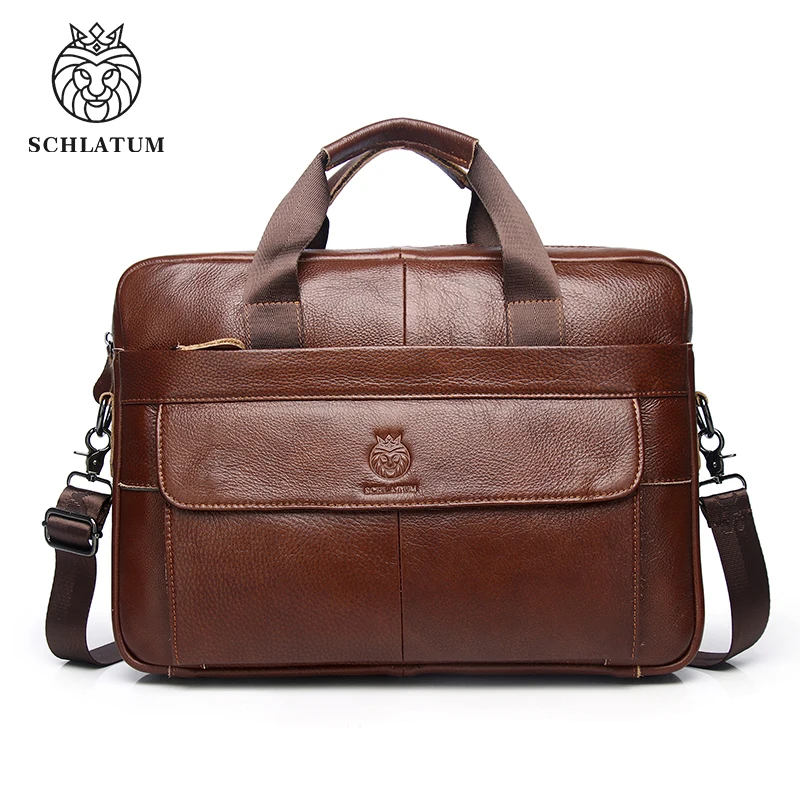
How Briefcase Materials Impact Size Considerations
The material of your briefcase significantly affects how size translates to weight and capacity. This is a crucial factor often overlooked when focusing solely on dimensions.
Leather briefcases, particularly those made from full-grain leather like those offered by Poise Porter, typically weigh more than synthetic options of identical size. A medium-sized leather briefcase might weigh 3-4 pounds empty, while a similar-sized nylon bag could weigh under 2 pounds. This difference becomes more pronounced as briefcase size increases.
Material flexibility also impacts effective capacity. Soft-sided briefcases can accommodate irregularly shaped items more easily, potentially offering more usable space than rigid options with identical dimensions. However, this flexibility may provide less protection for delicate items.
Consider material thickness as well—premium leather requires more substantial hardware and reinforcement, which slightly reduces internal capacity compared to thinner materials. A 16-inch leather briefcase and a 16-inch nylon briefcase may have the same external dimensions but different internal volumes.
Weather protection considerations also vary by material. Leather requires more care in wet conditions but offers better protection against punctures or abrasions. Synthetic materials might be more water-resistant but could require larger dimensions to incorporate the same level of padding and protection.
For comprehensive information about how different materials affect briefcase performance and appearance, our definitive guide on the ideal leather briefcase provides valuable insights for making informed decisions.
FAQ: Common Questions About Briefcase Sizing
What’s the best briefcase size for frequent flyers?
Frequent flyers should consider medium briefcases around 16” × 12” × 5” that qualify as personal items on most airlines while providing enough space for travel essentials. Look for options with a pass-through strap to secure it to rolling luggage handles.
Can a briefcase be too big for a professional setting?
Yes, an oversized briefcase can appear cumbersome and undermine your professional image, particularly in formal environments or executive meetings. For most corporate settings, staying within 16-17 inches wide presents a polished appearance.
How do I know if my documents will fit without wrinkling?
For standard letter-sized documents (8.5” × 11”), your briefcase should be at least 12 inches tall and 9.5 inches wide internally. For legal documents (8.5” × 14”), ensure the briefcase is at least 15 inches tall internally. The rigidity of the briefcase also affects document protection.
Should briefcase size change based on season?
Winter often requires slightly larger capacity as bulkier clothing (gloves, scarves) and potentially an umbrella may need storage. Many professionals find a medium briefcase with expansion capabilities works year-round, allowing adjustment as seasonal needs change.
Do standard briefcase sizes differ between men’s and women’s styles?
While marketing may distinguish between men’s and women’s briefcases, the functional sizing categories remain consistent. The main differences typically involve aesthetic details, handle lengths, and sometimes shoulder strap positioning rather than carrying capacity.
Does Briefcase Size Affect Organization and Accessibility?
The size of your briefcase directly influences how effectively you can organize and access your belongings. Each size category offers distinct organizational advantages and challenges.
Smaller briefcases typically feature streamlined organization systems with fewer but more precisely designed compartments. This minimalist approach makes items more immediately visible but limits categorization options. In a compact briefcase, you might have instant access to essentials but less ability to separate items by category.
Medium-sized options strike a balance with moderate compartmentalization—usually featuring a laptop section, document area, and several smaller pockets for accessories. This arrangement typically offers the most intuitive organization, allowing you to group similar items while maintaining relatively quick access.
Larger briefcases provide extensive organization options with numerous specialized compartments but can sometimes create “search challenges” when items settle at the bottom of deep pockets. Many professionals report spending more time looking for specific items in larger bags despite their superior organizational features.
Regardless of size, look for these organization-enhancing features:
* Contrasting interior lining for better visibility
* Compartments of varying sizes rather than several identical pockets
* Key leashes or tethers for frequently accessed items
* External quick-access pockets for essentials
The relationship between size and accessibility is important to consider based on how you typically use your briefcase. If you frequently need to retrieve items while standing (like on public transit), a smaller or medium option may prove more functional despite limited capacity.
How to Adjust Your Briefcase Choice for Special Circumstances
While your primary briefcase should accommodate your typical daily needs, certain situations may call for flexibility in your approach to sizing.
For special presentations or client meetings, you might temporarily need additional capacity for samples, portfolios, or handouts. Rather than permanently upsizing your daily briefcase, consider supplementary options like a slim portfolio case that complements your regular briefcase on these occasions.
Business travel presents unique challenges that might exceed even a large briefcase’s capacity. Many professionals maintain a medium everyday briefcase while investing in a dedicated overnight bag with a laptop compartment for trips. This strategy prevents carrying an oversized bag during regular workdays.
Seasonal adjustments are worth considering as well. Winter coats and accessories consume more personal space on commutes, potentially making your briefcase feel more cramped. Some professionals prefer a slightly larger option during colder months or briefcases with expandable features to accommodate seasonal variations.
Industry conferences or training sessions often require materials beyond your daily essentials. For these occasional needs, expandable briefcases with zipper extensions can temporarily increase capacity by 20-30% without permanently committing to a larger size.
The key to managing special circumstances is recognizing that your primary briefcase should suit your most frequent needs, with adaptability or supplementary options for exceptional situations. This approach maintains daily comfort and professional appearance while providing flexibility for varying demands.

